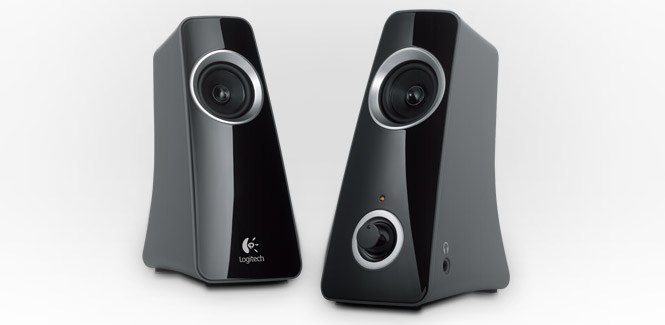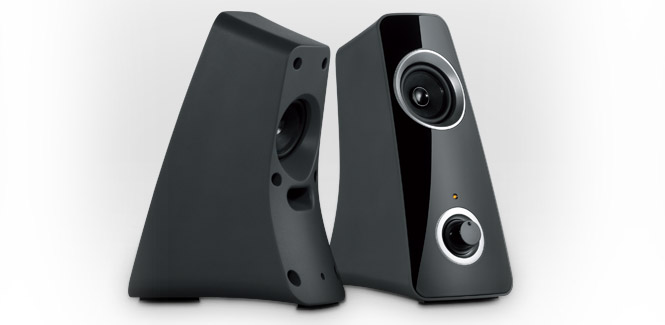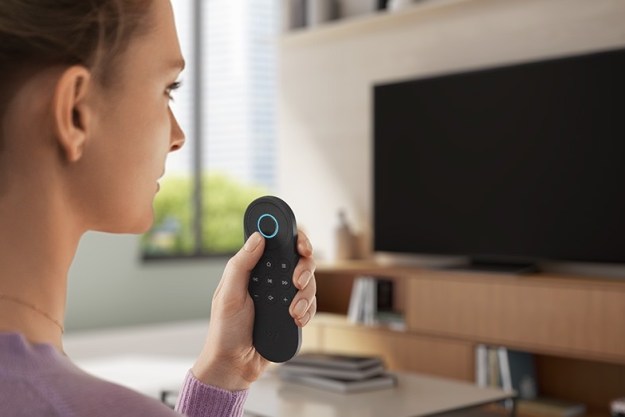
“We never expected speakers this cheap—okay, inexpensive—to sound this good.”
- Excellent sound
- Great bass output
- Inputs for three stereo sources
- Attractive
- Strong price/performance ratio
- Hard-wired cables
- Harsh highs nearing full volume
- Plastic satellite cabinets
- Won’t fill a large room

Have you ever wondered why more audio companies aren’t building PC speakers these days? Listen to Logitech’s Z523 speaker system and you’ll ask a second question that handily explains the first: How in the world can any company manufacture powered speakers that sound this good and sell them for a hundred bucks? Before the audiophiles in the crowd issue a fatwa on us though, let us be clear in that we are praising these speakers chiefly for their price/performance ratio. They suffer mightily in comparison to some of the pricier speakers we’ve auditioned—Audioengine USA’s $350 A5, for example, but frankly, we haven’t heard anything that comes close to the Z523 at this price range.
Features
The Z523 is a 2.1-channel speaker system, meaning it consists of small stereo speakers augmented by a larger subwoofer that handles bass duties. All three speakers are driven by a 40-watt amplifier housed in the subwoofer (sending 9.5 watts per channel to the satellite speakers and 21 watts to the sub). The curvaceous satellites exude a modern art sensibility, with curved faces that tilt their two-inch dome drivers up toward your ears. We’re not big fans of the fingerprint-prone glossy black finish, though.
Looking for a way to enable small speakers to fill a room, Logitech’s engineers came up with an unusual solution: A second set of drivers on the back of each satellite project sound out the rear of the enclosures as well as the front. You wouldn’t want to use these speakers for critical listening tasks, such as mixing home recordings, because the sound waves emanating from the rear arrive at your ears a fraction of a second after those generated by the driver itself. But the trick works remarkably well for casual music listening and gaming.

The satellite cabinets are fabricated from black plastic (and we’re not fans of faux-lacquer finishes, so we’re glad they limited this material to the front), but the subwoofer is housed in non-resonating medium-density fiberboard (MDF). The sub features a 4-inch down-firing driver, with a 6.5-inch pressure driver helping to fulfill the mission of delivering room-filling sound. Logitech claims a refreshingly realistic frequency-response range of 35Hz to 20kHz for the system.
Logitech is fond of using hard-wired cables, which we presume renders the speakers easier and cheaper to manufacture, so we can’t complain too much about considering the price tag. The left speaker has a 6.5-foot cable with an RCA plug that connects to the subwoofer. The right speaker has two cables of this length: One ends in a D-sub connector that plugs into the subwoofer, and the other has a 1/8-inch stereo plug that connects to your sound source. While this does render the setup process relatively idiot-proof, we had to go hunting for an adapter to connect the speakers to our PC’s high-end sound card, which is outfitted with left and right RCA jacks.

Performance
We tested the speakers with both games and music and were bowled over by both the volume and the quality of sound they produced. Listening to Paul Thorn’s “Where Was I?” ripped from his Ain’t Love Strange CD and losslessly compressed using FLAC, we were delighted with the speakers’ presentation of the guitar, Hammond B3, and sparkling mandolin. The system had no problem filling our 13.6-by-8-foot home office with sound.
We were equally pleased with the Z523’s gaming performance. We played a bit of Bethesda’s epic role-playing game Fallout 3 because it has one of the best soundtracks in gaming (complete with voice-acting by Liam Neeson and Malcolm McDowell). The subwoofer might be small, but it certainly didn’t leave us wanting.

These aren’t near-field speakers, but you shouldn’t expect them to fill a large room or to compete with a crowd at a party. When we switched over to John Hiatt’s “Take it Back,” from his Crossing Muddy Waters CD, and pushed the system past 80 percent of its maximum output, we began to imagine the gravel-voiced singer physically blasting through one of the speakers to bite off our ear.
Conclusion
You know you’ve found a great value in speakers when the only criticisms you can lob at them are that they lack modular cables, and that they sound grating when you crank them to near full volume. As a whole, Logitech’s Z523 speaker system delivered exceptional performance with both music and games, which is a remarkable accomplishment for speakers in this price range. But let’s be brutally honest as well: These speakers won’t satisfy everyone’s appetite. If you care deeply about audio quality and have the budget to indulge your obsession, you’ll find plenty of superior solutions on the market. However, by the same token, if you care deeply about audio quality and don’t have the budget to indulge your obsession, we think you’ll be happy with this solution.
Highs:
- Excellent sound
- Great bass output
- Inputs for three stereo sources
- Attractive
- Strong price/performance ratio
Lows:
- Hard-wired cables
- Harsh highs nearing full volume
- Plastic satellite cabinets
- Won’t fill a large room
Editors' Recommendations
- The best gaming speakers for 2023
- Sonos Voice Control hands-off review: Now we’re talking
- Tivoli Model One Digital radio hands-on review: Small changes, big difference
- Logitech has killed the Harmony universal remote control
- Google Nest Mini hands-on review: New name, few changes


